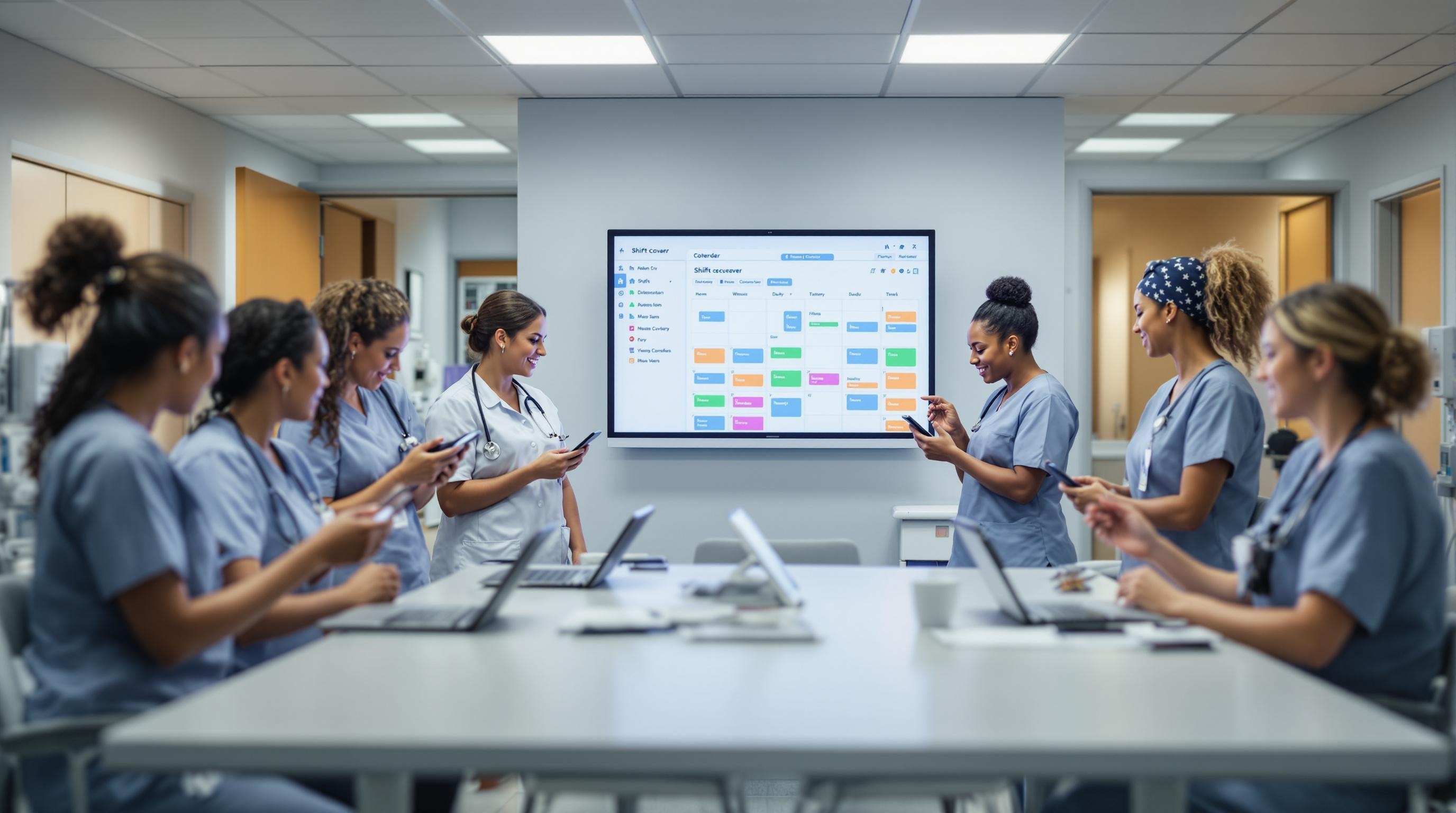Nursing Shift Report Automation: Boosting Efficiency in SNFs
Discover how nursing shift report automation streamlines workflows, reduces errors, and improves care quality in skilled nursing facilities.
Quick Navigation
- 1. Introduction
- 2. Current Challenges in Nursing Shift Report Automation
- 3. How Sparkco AI Transforms Nursing Shift Report Automation
- 4. Measurable Benefits and ROI
- 5. Implementation Best Practices
- 6. Real-World Examples
- 7. The Future of Nursing Shift Report Automation
- 8. Conclusion & Call to Action
1. Introduction
As the nursing shortage intensifies—projected to reach a global gap of up to 13 million nurses in the coming years—skilled nursing facilities (SNFs) are under mounting pressure to do more with less. The challenge is not just about staffing; it’s about ensuring that every handoff between caregivers is seamless, accurate, and efficient. At the heart of this challenge lies the nursing shift report—a critical process for communicating patient information, care plans, and urgent needs between outgoing and incoming teams. Yet, traditional shift reports, often reliant on handwritten notes or fragmented electronic records, are prone to information gaps, inconsistencies, and lost time—issues that can directly impact patient outcomes and staff well-being.
Fortunately, the future of nursing documentation is evolving rapidly. Emerging technologies, including automation and artificial intelligence (AI), promise to revolutionize the way shift reports are conducted—turning a time-consuming administrative task into a streamlined, reliable process. Automation not only reduces the risk of errors and omissions but also empowers nurses to spend more time at the bedside, enhancing both care quality and job satisfaction.
In this article, we’ll explore the current challenges facing shift reporting in skilled nursing facilities, examine how automation is transforming this essential workflow, and highlight the benefits for residents, staff, and organizations alike. Whether you’re a nursing leader, administrator, or frontline caregiver, read on to discover how embracing shift report automation can help your facility thrive in a landscape of growing demand and rapid change.
2. Current Challenges in Nursing Shift Report Automation
Nursing shift report automation is transforming how healthcare facilities manage patient handoffs and communication. While the technology promises increased efficiency and enhanced patient safety, its implementation comes with a unique set of challenges. Below, we explore key pain points facilities face, supported by current research and data, along with their impact on operations, compliance, and patient care.
-
Integration with Existing EHR Systems
Many nursing shift report automation tools must interface seamlessly with Electronic Health Records (EHR). However, interoperability remains a significant hurdle. According to a 2022 Health Affairs report, 57% of healthcare executives cite integration challenges as a primary barrier to adopting new health IT solutions. Fragmented data sources can result in incomplete or delayed shift reports, impacting care continuity. -
User Adoption and Training
Successful automation depends on staff buy-in and proficiency. A study in JMIR Nursing found that 43% of nurses experienced increased stress when implementing digital shift reporting due to insufficient training. Resistance to new workflows can cause parallel manual processes to persist, negating automation benefits. -
Data Accuracy and Quality
Automated systems rely on accurate and timely data entry. Errors in input or outdated information can propagate quickly, leading to clinical miscommunication. The Agency for Healthcare Research and Quality (AHRQ) notes that 80% of serious medical errors involve miscommunication during care transitions, often exacerbated by poor data quality (AHRQ Patient Safety Network). -
Customization and Flexibility
Facilities vary in workflow, patient acuity, and reporting needs. Out-of-the-box automation solutions may not account for site-specific requirements, forcing nurses to work around system limitations. This lack of flexibility can impede adoption and reduce the value of automation. -
Compliance and Data Security
Automated shift reports must comply with HIPAA and other regulatory standards. Inadequate security measures risk data breaches and legal penalties. According to the HIPAA Journal 2023 Healthcare Data Breach Report, healthcare data breaches rose 17% year-over-year, highlighting the critical need for secure automation protocols. -
Cost of Implementation and Maintenance
Budget constraints can stall or limit automation projects. The upfront investment in software, hardware, and training is substantial. A 2023 ONC data brief found that 42% of small and mid-sized facilities cite cost as a primary barrier to digital transformation. -
Workflow Disruptions
Transitioning to automated reports often introduces temporary workflow disruptions. Downtime, system glitches, or poor user interface design can lead to delays and staff frustration, interrupting critical handoff communication.
These challenges directly affect operational efficiency, regulatory compliance, and—most importantly—patient care quality. Ineffective shift report automation can increase the risk of medical errors, slow down care transitions, and cause staff dissatisfaction. Overcoming these barriers requires strategic planning, investment in staff training, and careful selection of solutions tailored to facility needs.
3. How Sparkco AI Transforms Nursing Shift Report Automation
Efficient nursing shift reports are vital for seamless patient care transitions in skilled nursing facilities. Traditional methods—often paper-based and manual—are prone to errors, time-consuming, and inconsistent. Sparkco AI directly addresses these nursing shift report automation challenges with advanced technology designed specifically for the healthcare environment. Here’s how Sparkco AI tackles key pain points through its unique features and capabilities:
-
Automated Data Collection
Sparkco AI automatically gathers patient information from electronic health records, medication logs, and other clinical systems. This eliminates the need for nurses to manually compile data, saving time and reducing the risk of missing critical information. -
Real-Time Report Generation
The platform generates up-to-date shift reports instantly, ensuring that incoming staff have access to the latest patient updates. This real-time capability keeps everyone on the same page and helps avoid miscommunication during handoffs. -
Intelligent Highlighting of Critical Changes
Sparkco AI uses smart algorithms to flag significant changes in a patient’s status, such as new symptoms or medication adjustments. By automatically bringing urgent issues to the forefront, it helps nurses prioritize care and respond quickly to evolving needs. -
Consistency and Standardization
By following best-practice templates and structured formats, Sparkco AI ensures that every shift report covers all essential details. This standardization reduces variability between staff and minimizes the risk of important information being overlooked. -
Seamless Integration with Existing Systems
Sparkco AI is designed to work with the electronic health record and scheduling systems already in use within skilled nursing facilities. Its flexible integration allows easy data exchange, so there’s no disruption to daily workflows or the need for complex technical changes. -
Secure Communication and Access Control
The platform ensures that only authorized personnel can view or edit shift reports, protecting patient privacy and meeting compliance standards. Automated access management makes it simple to add or remove staff as needed.
By automating data collection, report creation, and highlighting of critical information, Sparkco AI drastically reduces the administrative burden on nurses. Its real-time updates and standardized templates enhance clarity and reliability, while seamless integration with existing software ensures a smooth transition and minimal training requirements. All these benefits combine to create a more efficient, safer, and patient-centered shift reporting process in skilled nursing facilities.
4. Measurable Benefits and ROI
Automating the nursing shift report process is a powerful strategy for skilled nursing facilities aiming to improve efficiency, reduce costs, and ensure higher compliance standards. Emerging data and case studies show that leveraging automation technology for shift reports can drive significant return on investment (ROI). Below are several quantifiable benefits, supported by recent research and real-world implementations.
- Significant Cost Savings: According to an OnCall ROI study, facilities reported annual savings of over $65,000 per department after implementing scheduling and reporting automation. These savings stem from reduced overtime, improved staffing efficiency, and decreased administrative overhead.
- Time Savings for Nursing Staff: Automation slashes the manual time required for shift-to-shift handoffs. Facilities have noted up to a 75% reduction in time spent on shift reporting tasks. For a department with 55 staff members, this can equate to hundreds of hours saved annually, allowing nurses to focus more on patient care.
- Decreased Overtime Costs: Automated systems optimize shift transitions, reducing scheduling errors and last-minute coverage gaps. Organizations experience a 30-40% decrease in overtime expenses by eliminating manual miscommunication and streamlining staff allocation.
- Enhanced Compliance and Documentation Accuracy: Digitized reports ensure that all required information is consistently captured and securely stored. Automated shift reports have been associated with a 40% reduction in documentation errors, supporting better compliance with Centers for Medicare & Medicaid Services (CMS) regulations and reducing risk during audits.
- Improved Staff Satisfaction and Retention: Automation minimizes paperwork and manual data entry, reducing burnout and administrative burden. Facilities that implemented automated reporting reported a 15-20% improvement in nursing staff satisfaction scores, which correlates with lower turnover rates.
- Faster Onboarding for New Staff: Automated templates and standardized workflows make it easier for new nurses to learn and adapt to shift reporting processes. This shortens onboarding time by up to 25%, accelerating productivity for new hires.
- Reduced Risk of Missed Patient Information: Automated handoff tools ensure critical patient data is consistently communicated, decreasing the likelihood of adverse events due to incomplete reports. Some facilities have documented a 50% drop in shift-to-shift communication errors after deploying automation.
- Real-Time Analytics and Continuous Improvement: Automated systems provide facility administrators with real-time data on reporting compliance, shift trends, and staffing needs, enabling data-driven decision-making and ongoing process refinement.
In summary, the adoption of nursing shift report automation delivers robust ROI through measurable reductions in cost, time, and errors—while simultaneously elevating compliance and staff satisfaction. For more detailed metrics and case studies, review the OnCall ROI handout and related resources.
5. Implementation Best Practices
Automating nursing shift reports can significantly improve communication, compliance, and resident care in skilled nursing facilities—especially as CMS staffing and documentation requirements become more rigorous. However, successful implementation requires careful planning, stakeholder engagement, and ongoing support. Below are best practices to guide your facility through a seamless transition to nursing shift report automation.
-
Conduct a Comprehensive Needs Assessment
Evaluate your current shift handoff process, identify pain points, and determine specific goals for automation (e.g., reducing errors, saving time, improving compliance). Involve frontline staff in this assessment to ensure real-world challenges are addressed.
Tip: Use surveys or focus groups to gather input.
Common Pitfall: Skipping this step can result in adopting a solution that doesn't meet actual needs. -
Engage Stakeholders Early
Involve nursing staff, IT, compliance officers, and leadership from the outset. Their buy-in is essential for tool adoption and sustained success.
Tip: Identify champions among staff who can support peers.
Change Management: Early engagement reduces resistance and fosters ownership. -
Select the Right Automation Solution
Choose a platform that integrates smoothly with your EHR and complies with CMS documentation standards. Prioritize user-friendly interfaces and customizable templates for different care units.
Tip: Request demos and trial periods before finalizing.
Common Pitfall: Overlooking integration needs, leading to workflow disruptions. -
Develop Clear Policies and Procedures
Establish standardized protocols for shift report content, timing, and responsible personnel. Align policies with regulatory requirements and best practices.
Tip: Create quick-reference guides for staff.
Change Management: Clear policies minimize confusion during transition. -
Deliver Comprehensive Training
Provide hands-on training sessions tailored to different roles and shifts. Include troubleshooting tips and reinforce the importance of accurate documentation for compliance.
Tip: Offer refresher courses and on-demand training resources.
Common Pitfall: One-time training can lead to gaps in understanding—ongoing education is key. -
Pilot and Gather Feedback
Launch the solution with a small group or unit, monitor outcomes, and collect feedback. Adjust workflows and templates based on real-world usage.
Tip: Schedule regular check-ins with pilot users.
Change Management: Responsive adjustments build trust and promote wider adoption. -
Monitor, Measure, and Optimize
Track key metrics such as report completion rates, error reduction, and staff satisfaction. Use data to drive continuous improvement and report compliance to leadership and regulatory bodies.
Tip: Set up dashboards for real-time monitoring.
Common Pitfall: Neglecting ongoing evaluation can cause quality to stagnate. -
Communicate Success and Address Concerns
Share wins and lessons learned with the entire team. Acknowledge challenges openly and provide avenues for ongoing feedback.
Tip: Celebrate milestones to reinforce positive change.
Change Management: Transparent communication maintains morale and momentum.
By following these steps, skilled nursing facilities can implement nursing shift report automation that strengthens regulatory compliance, improves resident care, and empowers staff through streamlined communication and efficient workflows.
6. Real-World Examples
Real-World Examples of Nursing Shift Report Automation in Skilled Nursing Facilities
Adopting automated nursing shift reports has delivered measurable improvements in skilled nursing facilities (SNFs) across the country. The following anonymized case study illustrates the tangible benefits of this technology:
- Situation: A 120-bed skilled nursing facility in the Midwest struggled with inconsistent handoffs during nursing shift changes. Paper-based reports were prone to errors and omissions, resulting in frequent miscommunication, delayed care interventions, and compliance risks. The facility also reported a 22% staff turnover rate, partly attributed to staff dissatisfaction with time-consuming documentation processes.
- Solution: The administration implemented an automated shift report system integrated with the facility’s EHR. Nurses could now access real-time, standardized, and patient-specific handoff reports via secure tablets. Customizable templates ensured that critical data—










